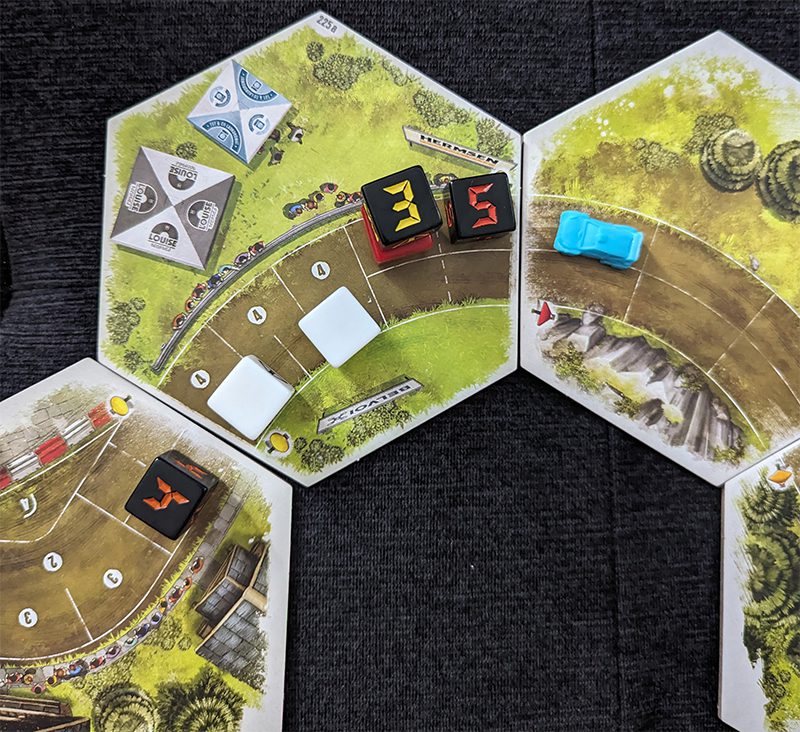Disclosure: Meeple Mountain received a free copy of this product in exchange for an honest, unbiased review. This review is not intended to be an endorsement.
Racing games have been around for a long time in the board game world. You can even classify games like Sorry, Candyland, and Snakes & Ladders as racing games. They involve moving pieces from a starting point to an end point, with the player reaching the finish line first being declared the winner.
However, if we narrow our focus to motorsports-themed racing games, the options become surprisingly scarce, as the majority of published board racing games revolve around either NASCAR or Formula 1 racing. Rallyman: DIRT stands out as perhaps one of the few examples of modern rally racing board games, a niche within the broader world of motorsports.
It’s a pity to point out that rally racing, despite its thrilling nature, often gets overlooked in the motorsports hierarchy. This sport involves pushing high-performance vehicles to their limits on terrain unsuitable for such extreme driving conditions. It’s this contrasting dynamic that makes rally racing exhilarating.
From a game design perspective, the sport of rallying offers a wealth of opportunities that go beyond simply replicating famous circuits like the Monaco GP, which is a common approach in many other racing games. Rally racing allows for the incorporation of diverse challenges such as uphill and downhill sections, jumps, drifting maneuvers, shortcuts, and treacherous surface conditions. As a game genre, rally racing provides a canvas for creating more obstacles and unpredictable scenarios.

Under the Hood
Rallyman: DIRT aims to capture the essence of rally racing through elements of risk management and good old-fashioned dice rolling. Similar to the real-life sport, each rally is divided into stages, and the objective is to achieve the lowest cumulative time compared to your opponents. This is a glorified time trial and players aren’t racing bumper to bumper here as they enter the stage through staggered starts, with the first place having two rounds before the next player goes.
The turns are quite simple. Each turn, you begin with a pool of dice and plan your trajectory by arranging them on the track before rolling. The black dice represent numbered “gear” dice, and the values must ascend or descend by one, unless you introduce a red “brake” die, which allows you to decrease by two gear values. Additionally, there are “coast” dice that enable you to move an extra space while maintaining your previous gear level.
That sounds straightforward, yet there are a few concerns that you must take heed of. Since this is a time trial, managing your time is paramount. The number of seconds you accrue depends on the gear value you end your turn on. For instance, if you end your turn in gear 6, that equates to 10 seconds, whereas gear 1 is a costly 50 seconds.
Brake to the Floor
There is also the rolling of the dice. After planning your move, you have two options. The first and safest is rolling one by one. The idea here is that you don’t want to roll 3 warning signs because, if you do, your car is taking a shortcut to the nearest tree. With the one-by-one method, you can stop at any time.
The real excitement kicks in when you opt to roll all the dice simultaneously. Similar to the one-by-one rolling method, you aim to avoid rolling three warning signs. However, the advantage of this approach is that you earn “second” tokens. These tokens can be spent later during the one-by-one rolling phase, allowing you to immediately lock in a successful dice roll, bypassing the need to physically roll. If you don’t use these tokens by the end of the round, they actually reduce your overall time, providing an incentive to use them strategically.
All of this sounds quite well done. You can throw caution in the wind and roll everything else at once, or do the safe one-by-one method with revealing information on each roll. It is a fantastic system yet it still maintains simplicity. The only thing that could prevent this system from reaching its peak would be if the navigation of the track was boring.
That isn’t the case. Corners are simple, as you cannot go over the speed limit; otherwise, you crash. However, there are different considerations when entering or exiting a turn. You have the option to either go straight, which counts as one space, or turn your car sideways for two spaces. The rationale here is to fine-tune your gear for time-saving purposes and plan your next turn.
Tactical Terrain Mastery
There are also jumps that allow you to skip spaces, but if you roll a warning sign on that particular die, you immediately crash. Water spaces can only be entered with a “1” gear die or a coastal die, so plan your trajectory accordingly. There are also shortcuts on certain corners that can permanently damage the corner spaces on the track tile due to debris or possibly damage your own car, reducing your die pool for the rest of the stage!
All of these micro-decisions you make are the engine that moves this game forward. These aren’t highly calculating and time-consuming decisions, but they are decisions nonetheless. Even during periods of downtime, you find yourself carefully planning your next moves while simultaneously harboring an urge to push the limits and go as fast as possible as if you just stole this car. This duality triggers a chemical reaction in your brain, igniting a competitive spirit, especially when pitting your skills against others in this game of one-upmanship.
It’s also at this point that I need to talk about player scaling. In plain terms, this isn’t a 6-player game, as mentioned on the box. It is, at most, a four-player game, and even then, I would be hesitant to play. The source of this accusation is the staggered start system, like in rally sports. After the first player completes their second round, the second player enters the track. Similarly, the third player joins after the second player’s second round, and so on. As you can probably tell based on that description, downtime becomes an endurance test for players that come in late.
Player scaling also becomes an apparent issue when it comes to takeovers. Crashing in this game is an uncommon occurrence, and taking shortcuts can damage your car. Suffering damage to your car results in a reduction of your dice pool for the remainder of the stage, or potentially the entire rally. If this happens to the player at the front, it means they are moving fewer spaces, theoretically making it easier for trailing players to catch up. That sounds good, until you realize this potential catch-up mechanic is undermined by the fact that the leading player can simply turn their car sideways during corners, effectively blocking other players from overtaking them.

Refining the Ride
Fortunately for Rallyman: Dirt, its strengths overshadow its weaknesses. When played with two or three players, the game offers a fine example of tactical decision-making interwoven with clever push-your-luck mechanisms to explore. Elements such as jumps, water spaces, drifting, and corner spaces are designed to disrupt your perfect racing lines, adding an engaging layer of complexity.
Even the potentially frustrating aspect of crashing, which was a major issue in Rallyman: GT, is mitigated since time trials allow for a spectrum of success and failure, as opposed to the binary point system found in Rallyman: GT. While a crash may have initially added a minute to your time, you can significantly reduce that penalty by carefully planning the remainder of the stage through high gears and clever use of second tokens.
That said, the impact of crashing cannot be overlooked. If anything, I wish it didn’t hold such a significant influence over the game’s outcome. In most of the sessions I played for this review, the determining factor boiled down to who crashed the least, rather than shrewd usage of second tokens.
Because of the three warning signs that can appear in small dice pools as little as four, the 60-second penalty for crashing can be a dealbreaker for an entire rally. Compound this with damage tokens that reduce your dice pool for the stage, further exacerbating the issue, and it’s unsurprising that some players in my sessions lost emotional investment midway through a game. Personally, I’m fine with this punishment, but I can clearly see some players not enjoying this aspect of the game at all.
Overall, Rallyman: DIRT succeeds in capturing the thrilling essence of rally racing within the confines of board games. While it may have its flaws, particularly when it comes to player scaling and downtime, the game shines when played with two or three players. Its blend of tactical decision-making and push-your-luck mechanics creates an engaging event that one can appreciate. If you’re looking for a fresh approach to racing board games, Rallyman: DIRT is a worthy contender to consider.











